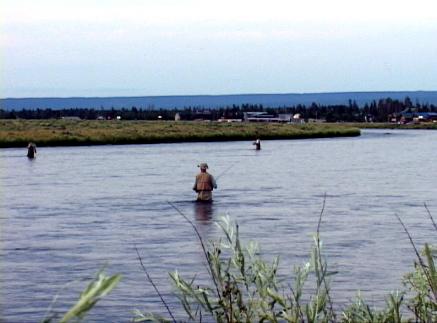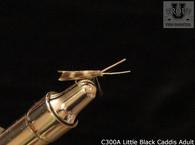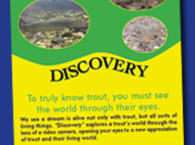
Henrys Fork of the Snake River was named for Andrew Henry, a fur trader who first saw it in 1810. It starts at Henry’s Lake in Eastern Idaho which is fed by seven cold creeks, and huge, icy springs in its bottom. The 30 mile wide lake has very fertile icy cold water making it an ideal trout habitat. With a pedigree like that and with the capability of catching an 18 pound trout, it is of little wonder that the Henry’s Fork of the Snake River has been voted number one by Trout Unlimited members.
The Henrys Fork begins at Big Springs, then winds through the Box Canyon and Harriman State Park, then over the spectacular Upper and Lower Mesa Falls and continues a total of 150 miles down to Ashton, where it joins the Snake River. With a few exceptions, it behaves like a gentle flowing giant freestone creek with quality pocket water. The Henry is known for its huge rainbow trout often over 20 inches in length and its classic dry fly fishing.
After leaving the dam at Henry’s Lake, the river flows over flat meadows, in a series of quiet runs and deep pools with marshy types of banks. This section, containing only wild trout, flows for about 10 miles before it comes to the confluence with Big Springs. It has few holding spots so the trout will be found primarily in the deeper pools. Also note that there is no fishing in Big Springs which is a good nursery for rainbow trout.
The section from the Big Springs confluence down to the U.S. Highway 191 Bridge at the hamlet of Mack's Inn is more of the same type of waters and for the most part is all private. However, if you can find access to this excellent water, you will be in prime water for some rewarding hatches of the tiny Midge and Blackflies.
The next 8 mile section flows downstream to the head of Island Park Reservoir. This section is characterized by long runs, and riffles, punctuated with beautiful pools however; there is one small canyon between Upper and Lower Coffee Pot rapids. This section down to Island Park Reservoir is a popular portion of water and it contains stocked as well as wild rainbow trout.
However, the most popular stretch of Henry’s Fork is the 20 miles beginning below Island Park Reservoir. About one mile below the outflow of the reservoir; the Buffalo River joins Henry's Fork and starts the Box Canyon which is famous for its huge rainbows and for its famous Salmonfly hatch. The Box Canyon is a 3 mile section of fast water contained by steep walls. Due to the fast water, the techniques used in the box canyon are completely different from most other areas.
Below the box canyon is the Harrimon State Park which includes about seven miles of water containing a tremendous aquatic insect population especially known for the popular green drake hatch which normally occurs in late June. The Henry’s Fork can become crowded at this time of the year. Access is very plentiful and easy for the state park area of the river.
The Henry’s fork flows a few more miles before it passes through the Riverside Campground and then it enters the beautiful Cardiac Canyon. The next 8 miles contains some beautiful pocket water before reaching the Upper and Lower Mesa falls. Access is rather short in this section, but there are a couple of sections that can be floated in a drift boat. Fast water tactics should be practiced here including the use of nymphs and streamers.
After leaving Mesa Falls the river again slows down in a normal pace for several miles before reaching the confluence of the Warm River. After being joined by the Warm River the Henry's Fork flows a few more miles before reaching Ashton Reservoir. This stretch contains brown trout and a small population of Yellowstone Cutthroats in addition to the famous rainbow trout.
The 7 mile tail-water section of water below Ashton Reservoir, down to Chester Reservoir is an excellent cold water fishery with some excellent hatches. This section receives considerably less fishing pressure but is still well worthy of mention.
Below Chester Dam downstream to St. Anthony you will find another section of water, where the brown trout have become much more plentiful, however access is limited in this section. The river is also fishable below St. Anthony but there are fewer trout coupled with prospects for limited access.
Fishing the Henry’s Fork:
Fishing the Henry’s Fork is a study in diversity as it has the characteristics of s spring creek, a freestone creek and a tailwater fishery along its many miles. It can be waded across in most areas, yet there are some turbulent areas. While it is shallow for the most part, there are some deep holes only a few feet away. The mass of aquatic vegetation on the bottom causes tricky currents making it difficult to get a drag free drift.
Now, the good news! The prolific hatches on the Henry’s Fork include the Pale Morning Duns, Blue Winged Olives, Green Drakes, Gray Drakes, Mahogany Duns as well as Caddis. In addition to the Mayflies and the Caddis, there exist excellent hatches of stoneflies including the Golden Stones, Salmon Flies, and Yellow Sallies. A great portion of the Henry’s Fork for the Stonefly hatches is the fast water in the Box Canyon.
Also, be sure to check out our Henry's Fork Hatch Chart before you go.
Spring:
Spring brings on the big hatches of the Blue winged Olives starting in April, followed by the hatches of Salmonflies in May. but some of the trout will prefer the smaller flies such as the Midges.
Summer:
Summer will see the hatches of the Pale Morning Duns, the Yellow Sallies, the Golden Stoneflies and the famous Green Drakes, but do not overlook the Caddisflies as they hatch pretty much through the year. In the fast water, the streamers will work well and when the surroundings include the flat grassy areas, the terrestrials will coax some large trout into your net.
Fall:
The fall season can provide some excellent fishing with the Gray Drakes and the Mahogany Duns hatching along with the Caddisflies hatching as well.
Winter:
While the season above Vernon Bridge lasts from near the end of May until November, below the Vernon Bridge you can fish year-round and it is legal to fish year around in Idaho. The classical winter standard of Midge nymph patterns will be in practice.
Access to Henry's fork can be found along Route 20, Route 47, as well as smaller side roads along the river.
The Box Canyon can be reached by the road leading to the reservoir north of Pond’s Lodge. It will be necessary to turn off this road and proceed to the boat launching area which is over a mile below the tailrace. Another good place to access this area is the Box Creek Campground.
View Western USA in a larger map





